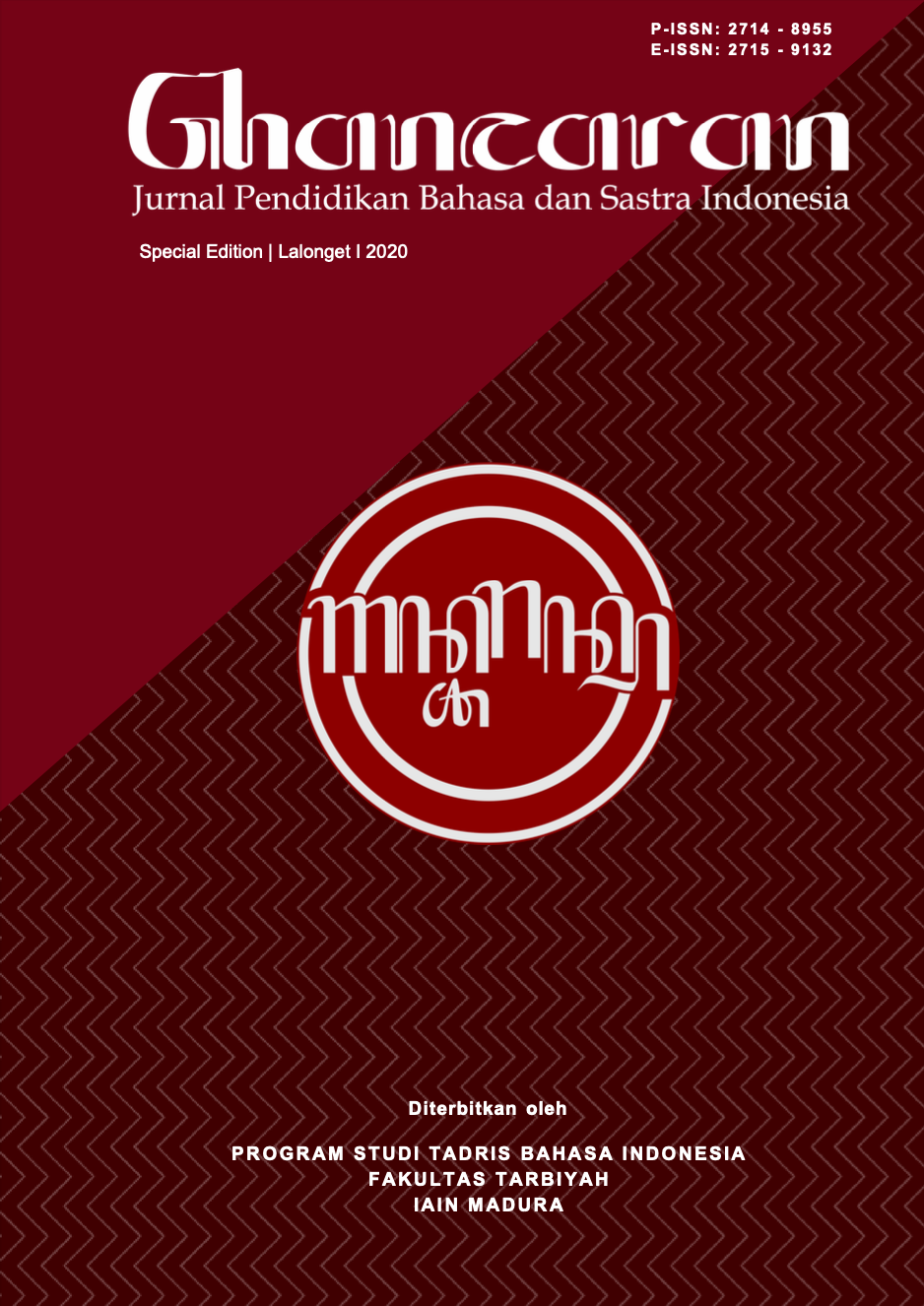MENGENAL PEMBELAJARAN BIPA BERDASARKAN KEBUTUHAN BELAJAR PELAJAR ASING
 Abstract views: 635
,
Abstract views: 635
,
 XML downloads: 554
XML downloads: 554
Abstract
BIPA Learning is an Indonesian language learning program specifically designed to provide language learning services for foreign students. In BIPA learning, teaching materials and learning strategies are specifically designed according to the learning needs of foreign students. BIPA students are students as speakers of other languages who have diverse cultural backgrounds and learning goals. Cultural diversity and learning objectives of BIPA students have implications for the difficulty in choosing appropriate materials and strategies for implementing BIPA learning. The suitability of the choice of materials and strategies with the needs of BIPA students can motivate students and improve learning effectiveness. Therefore, an adequate understanding of student characteristics, learning needs, and teaching materials are important aspects that need to be mastered by BIPA teachers.
Downloads
References
Khojasteh, L., Shokrpour, N., & Torabiardakani, N. 2017. EFL Advanced Adult Learners’ Use of English Modals in Narrative Composition. Pertanika J. Soc. Sci. & Hum. 25 (4): 1601-1612, (2017), diambil dari: http://www.pertanika. upm.edu.my/ regular_ issues.php?jtype=3&journal=JSSH-25-4-12.
Leung, C. & Scarino, A. 2016. Reconceptualizing the Nature of Goals and Outcomes in Language/s Education. The Modern Language Journal, 100 (Supplement 2016) DOI: 10.1111/modl.123000026-7902/16/81–95 $1.50/0 C _ 2016 The Modern Language Journal
Meyer, H.–D., & Benavot, A. (2013). PISA and the globalization of education governance: Some puzzles and problems. In H.–D. Meyer & A. Benavot (Eds.), PISA, power, and policy: The emergence of global educational governanace (pp. 7–26). Oxford, UK: Symposium Books.
Moo, M. (2016). A Correlational-Comparative Study Of Students’ Perceptual Learning Style Preferences In Learning English As A Foreign Language And Their Academic Achievement In The Cetana Academic Program For English At Myanmar Institute Of Theology . Thailand: Assumption University of Thailand, diambil dari: http://repository.au.edu/bitstream/handle/6623004553/ 19506/AU-Thesis-Fulltext-195 06.pdf?sequence=3
Panggabean, H., Juliana, M., & Hora, T. (2013). Profiling intercultural competence of Indonesians in Asian Workgroups. International Journal of Intercultural Relations, 37(2013), 86–98. Retrieved July 31, 2014, from http://dx.doi.org/10.1016/ j.ij intrel .2012.04.002
Rosyada. (2003). Paradigma Pendidikan Demokratis. Jakarta: Kencana.
Sagala, S. (2006). Konsep dan Makna Pembelajaran. CV Alfabeta
Sanjaya, W. (2009). Perencanaandan Desain Sistem Pembelajaran. Jakarta:Kencana
Sharifian, F. (2010). Cultural conceptualisations in intercultural communication: A study of Aboriginal and non-Aboriginal Australians. Journal of Pragmatics, 42(2010), 3367–3376. doi:10.1016/j.pragma.2010.05.006.
Sharma, Ma Dha V P. & Jung, Loren B. (1985). How Cross-Cultural Social Participation Affects The International Attitudes Of U.S. Students, International Journa of Intercultural Relations. Vol 9, 1985.
Slattery, P. (2003). Hermeneutics, subjectivity and aesthetics: Internationalizing the interpretive process in U.S. curriculum research. In W. F. Pinar (Ed.), International handbook of curriculum research (pp. 651–665). Mahwah, NJ: Lawrence Erlbaum.
Suyitno, I.; Fawzi, A., Susanto, G., Anggari, P.D., Arista, H.D. (2019). Designing Indonesian Learning Materials for Communicative Purposes for Foreign Learners, dikutip dari International Journal of Learning, Teaching and Educational Research, Vol 18, No 10 (2019).
Suyitno, I. (2017). Norma Pedagogis Pembelajaran BIPA: Deskripsi Teoretis dan Hasil Kajian Empiris. Bandung: Refika Aditama.
Suyitno, I., Susanto, G., Kamal, M., & Fawzi, A. (2017). Cognitive Learning Strategy of BIPA Students in Learning the Indonesian Language, IAFOR Journal of Language Learning, Volume 3 – Issue 2 – Winter 2017, Published January 15, 2018.
van Schaik, C. P., & Burkart, J. M. (2011). Social learning and evolution: The cultural intelligence hypothesis. Philosophical Transactions of the Royal Society B: Biological Sciences, 366(1567), 1008–1016. https://doi.org/10.1098/rstb.2010.0304.
Wardhaugh, R. (2002). An introduction to sociolinguistics (Fourth Ed.). Oxford: Blackwell Publishers.
Ghancaran: Jurnal Pendidikan Bahasa dan Sastra Indonesia uses an Open Access Policy under the Creative Commons Attribution-ShareAlike 4.0 International License. Authors publishing in this journal agree to the following terms:
- Ghancaran Journal holds the copyright and grants the journal rights for first publication with the work simultaneously licensed under a

The work is distributed under Creative Commons Attribution-ShareAlike 4.0 International License which allows others to share, copy, and redistribute the material in any media or format and adapt, remix, change, and develop the material even for commercial purposes, as long as it is stated credit and license derivative works under similar terms. - Authors may make additional contractual arrangements for non-exclusive distribution of the journal's published work version.
- Authors are permitted to post their work online (e.g., in institutional repositories or on their websites) before and during submission, as doing so may lead to productive exchange.



















